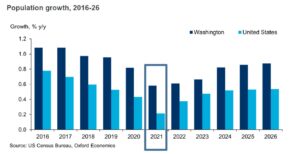As we roll into 2022, we are reminded of the Bill Murray movie “Groundhog Day” where Murray relives the same day over and over again. However, underlying this sense of sameness where many feel like they are repeatedly navigating masks, social distancing, school closures, tests, isolation etc., is an evolution of the social, political, business and economic climate that will have a profound effect on our economy going forward. 2021 was marked by continued supply chain disruption, an increase in political tribalism, massive Government spending, growing shortages of goods and, of course, the rise of inflation. From a real estate perspective, cap rates continued to fall for apartments and industrial, construction costs continued to escalate, and alternative asset classes entered the mainstream.
While growing political polarization should be a concern for every American and could potentially have a more massive impact than all the factors mentioned above, we choose to focus on those areas where the impacts are more readily predictable, particularly on real estate values. For several years prior to 2021, the ability of real estate to generate increasing levels of cash flow depended on economic growth and controlled new supply. This has been hard to accomplish in recent years because, despite muted economic growth, an abundance of both debt and equity capital has stood at the ready to fund almost any new project. Although owners and developers have had a hard time growing the bottom line due to this constant supply of new product, they have been bailed out by ever-falling cap rates, which has accounted for almost all the recent rise in values. However, in 2021, the landscape shifted as rents rose significantly in favored asset classes, increasing forward income and driving cap rates even lower. This was great news for investors who happened to be in those favored asset classes.
In 2021, we entered a demand driven real estate environment characterized by robust economic growth with supply struggling to catch up. It is no secret that industrial demand has been growing for the last several years, fueled by e-commerce and accelerated by the pandemic, yet, according to Cushman Wakefield, in 2021 net absorption nationally was a record-breaking 532 million square feet, while new supply was only 355 million square feet. The national vacancy rate for industrial assets dropped to 3.7% while rents grew by almost 10%. For the local industrial market, asking rental rates are now the highest on record and net absorption in 2021 was 51% higher than in 2020. The Washington region’s multifamily market also saw record absorption in 2021 and vacancy rates dropped by 220 bps for all classes of apartments to 2.5% while rents rose at close to 15%, exceeding pre-pandemic levels.
Government spending bills, measuring in the trillions of dollars, have supported the consumer’s appetite to spend. At the same time, the current supply chain disfunction has caused delivery delays across the board from consumer goods to construction materials. If you are an owner of real estate, you are seeing robust rent growth. However, if you are trying to build new product, you are suffering from sticker shock on materials and labor costs while struggling with delivery time frames. As a result, underwriting becomes more challenging with rising costs and increasing timing risk compromising development pro formas. While developers struggle to navigate these dynamics, end-users of real estate (outside of the office sector) face similar challenges, whether it be individuals trying to secure affordable housing or businesses finding space to service their growing customer demand in the face of accelerating rental rates.
There are two other 2021 trends of note that piqued our interest, one national and one at the local level. In light of falling yields in traditional real estate sectors, alternative real estate asset classes entered the institutional mainstream to the tune of $80 billion of new investment. With the stagnation of the office market and steep competition for multifamily and industrial assets, traditional institutional investors turned their attention to single family rentals, self-storage, data centers, senior living, and life sciences among other niche product types, in search of returns. We anticipate this trend accelerating into 2022.
As expected, throughout the pandemic the Washington region has fared better than the country as a whole, marked by a less severe reduction in population growth. What is interesting, however, is the outsized population growth in the region in 2021 when compared to the US average. With population gains of over 37,000 in 2021, the region grew at almost 3x the national rate. This could partially explain the booming apartment market and is likely the result of an influx of Amazon HQ2 employees, growth in the federal workforce after the change of administration, historic levels of government stimulus spending locally and the dramatic rise in life science employment in the wake of the pandemic. As you can see from the Oxford Economics chart below, the Washington region is projected to continue growing at a more rapid rate than the US as a whole over the next few years.

